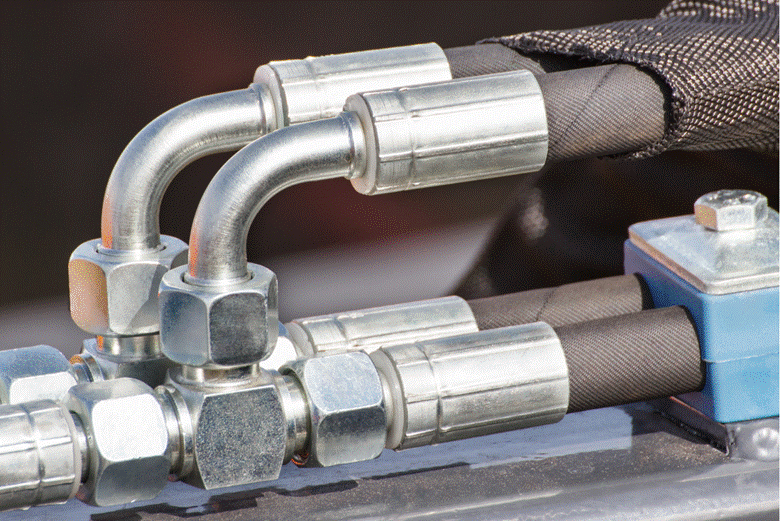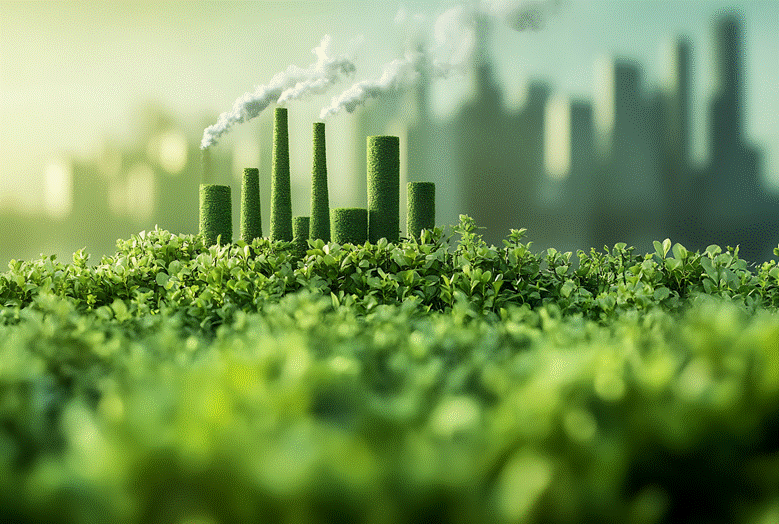With the growing focus on sustainability and the environment, many industries have begun implementing cleaner manufacturing practices to satisfy consumers’ and legislators’ demands. The fluid power industry has come under scrutiny, too, and it has been established that much needs to be done to minimize its environmental impact.
In this article, we will examine how manufacturers can improve sustainability in the fluid power industry, what steps have already been made, and how modern pneumatics and hydraulics benefit the environment.
How Fluid Power Works — And Why Sustainability Matters
Fluid power systems use pressurized fluid (oil, water, air) to transmit force efficiently across machinery.
There are two branches:
- Hydraulics — liquid-based (typically oil), extremely high power density
- Pneumatics — compressed air or inert gas, lower power but faster and cleaner
Fluid power systems are essential in:
- Manufacturing
- Construction equipment
- Agriculture & forestry
- Material handling
- Marine systems
- Mining
- Energy sector
Why sustainability matters:
The fluid power sector accounts for significant industrial energy consumption, frequent leaks, and substantial waste generation from fluids, hoses, seals, and valves. Regulatory pressure and customer demand are forcing rapid modernization.
Sustainability in the Fluid Power Industry
The fluid power industry leverages technologies that use a fluid to transmit power from one location to another. Based on the fluid used, there are two types: hydraulics with liquids like oil or water, and pneumatics, which use gas, such as compressed air.
Aside from fluid power, power transmission systems can be electrical and mechanical, both of which are useful in different settings and applications. However, if we speak strictly about sustainability, electrical systems are considered the most environmentally friendly, while fluid and mechanical power lag behind.
That’s because, in the case of fluid power, energy efficiency is fairly low; slightly above 20% in many conventional hydraulic systems. Much of the energy is lost through friction between the fluid and the pipe walls, which creates heat, or through leaks and component inefficiencies.
Furthermore, fluid power systems can directly harm the environment, especially when they utilize oil-based hydraulics. Oil spills are fairly common and may lead to pollution and contamination, affecting the flora and fauna in the area.
Lastly, the waste this kind of system creates is another challenge to sustainability. Many components, like seals and valves, need to be replaced eventually, which, of course, goes against the idea of recycling and reusing. It’s similar with fluids; when they aren’t disposed of correctly, they create extra waste.

Environmental Benefits of Modern Pneumatics and Hydraulics
Some of the issues mentioned above have been resolved in modern pneumatics and hydraulics, which are designed with sustainability in mind. The focus has been on enhancing energy efficiency, using cleaner fluids, and minimizing leakage.
So, for instance, companies like Regal Rexnord, which designs power transmission components, have successfully created more efficient systems by reducing the number of parts that comprise them. Specifically, this company developed a new type of hydraulic marine winch, which reduced the cost by 32% and improved energy efficiency by 3%.
Similarly, other companies have been focusing on minimizing leakage to protect the environment from pollution and reduce energy losses. John Deere is a good example; the agricultural equipment manufacturer has implemented advanced sealing technologies and improved hose routing to significantly reduce leakage risks.
As for using cleaner fluids, the fluid power industry is turning away from regular oil, which is highly damaging to the environment, and incorporating biodegradable options instead.
Vegetable oil and synthetic ester are good alternatives, but their applications are still very specialized due to their limited thermal and oxidative stability. However, they are already widely used in agriculture, forestry, and mobile hydraulics, even if they can’t cover all heavy-duty applications.
Hydraulics vs Pneumatics: A Sustainability Comparison
| Factor | Hydraulics | Pneumatics |
| Energy Efficiency | Moderate (20–30%) | Very low (2–10%) |
| Leak Risks | High, environmental contamination | Air leaks waste energy but are cleaner |
| Noise | Moderate | High noise from compressors |
| Power Density | Extremely high | Low |
| Waste Generation | High (oil, hoses, seals) | Lower fluid waste |
| Carbon Footprint | Medium–High | High due to compressor energy use |
| Best Use Cases | High-force applications | Fast, repetitive, low-force tasks |
Both systems have sustainability challenges, but modern innovations are closing the gap.
Challenges and Innovations in Sustainable Fluid Power
We’ve already mentioned some of the challenges related to sustainable fluid power, but here’s a quick and more in-depth overview:
- Inefficient designs. Many hydraulic and pneumatic systems weren’t built with energy efficiency in mind, so there’s significant energy loss through various components. As a result, the output is lower than it could be, and the fuel consumption is high.
- Maintenance. Materials that are in constant contact with fluids degrade with time and need to be regularly maintained and replaced. Discarded parts are essentially waste and must be properly handled to avoid harming the environment. Ideally, though, engineers should design more durable systems with significantly longer lifecycles.
- Environmental impact. Aside from waste and fuel consumption, fluid power negatively affects the environment through leaks, spillages, and contamination. This is especially true for hydraulic systems that use oil or pneumatic systems that use nitrogen. Pneumatics filled with compressed air are typically considered more eco-friendly.
Some of these challenges may be resolved through innovative designs, electrification, and digital integration.
For instance, many companies have begun replacing constantly running pumps with electric motors that operate only when needed and, therefore, save energy. These, paired with sensors connected to the Internet of Things (IoT), also collect performance data that enables them to detect leaks, predict component failures, and optimize operations to maximize efficiency.
Modern Innovations Making Fluid Power More Sustainable
Sustainability in fluid power is no longer just about helping the planet. It’s now a core part of running industries more efficiently, saving costs, and building systems that last longer. Across farms, factories, and heavy-equipment fleets, hydraulic and pneumatic machines are becoming cleaner, smarter, and far more energy-efficient.
Electrification & Hybrid Fluid Power
One big change is how power systems now work only when needed. Old hydraulic pumps used to run nonstop, even when idle.
New systems like servo-electric hydraulic pumps, electro-hydraulic actuators, and variable-speed drives switch on only when required.
This simple change cuts energy waste and reduces heat buildup.
Depending on use, these systems can save 50–80% of energy. They need less cooling, have fewer leaks, and last longer. By reducing pressure surges and idle time, they also lower wear and tear on parts.
The Rise of Smart Sensors and Predictive Maintenance
Digital technology has changed how we manage fluid power.
Tiny sensors now track pressure, temperature, flow, and wear across a system. The data is sent to online platforms that spot small issues before they become big problems.
This is called predictive maintenance. Instead of waiting for a failure, teams fix parts early.
Digital twins—virtual models of machines—can even predict how long each part will last.
The result: fewer breakdowns, less waste, and cleaner, safer workplaces.
Seal Innovations That Stop Leaks
Leaks have always been a major issue in hydraulics.
But modern seals are changing that. Companies like John Deere, Parker, and Eaton now use multi-lip seals, heat-resistant elastomers, and better hose routing.
They’ve even added low-friction coatings to reduce wear.
These improvements cut leaks by 25–50%. That saves money, avoids cleanup costs, and helps protect the environment.
Biodegradable Fluids: Cleaner Inside the System
What’s flowing inside the system matters too.
Traditional mineral oils are still common, but many companies now use biodegradable hydraulic fluids.
These include:
- Vegetable-based oils (HETG)
- Synthetic esters (HEES)
- Polyethylene glycol fluids (HEPG)
They break down naturally if spilled—often within 10 to 28 days.
They are safer for soil and water and less toxic for workers.
While some still struggle in extreme temperatures, many industries—like agriculture, marine, and construction—are switching because of lower environmental impact and easier compliance with regulations.
Smarter Components and Streamlined Designs
Manufacturers are rethinking how hydraulic systems are built.
Simpler designs mean fewer parts, less raw material, and easier recycling.
Example: Regal Rexnord redesigned its hydraulic marine winch. It used one-third fewer parts, improving energy efficiency while cutting costs.
Modern systems also reuse energy. New pumps and variable-displacement designs help capture heat and reduce fuel use, bringing hydraulics closer to the efficiency of all-electric systems.
Circular Economy and Remanufacturing
Sustainability now includes giving components a second life.
Instead of replacing parts, companies rebuild and reuse them.
Remanufacturing uses up to 80% fewer materials and cuts carbon output by about 60% compared to making new parts.
Used hydraulic oils are also re-refined and reused.
Even hoses and rubber parts are recycled into mats or new seals.
This reduces waste and cost while keeping systems running like new.
Regulations Driving the Change
Rules and standards are pushing companies to go greener.
- ISO 14001 promotes full lifecycle impact reviews.
- EU REACH limits hazardous chemicals in hydraulic fluids.
- EU Machinery Regulation 2023 adds sustainability to safety standards.
- S. EPA SPCC rules demand strict spill prevention.
- USDA BioPreferred Program rewards use of biodegradable fluids.
- OSHA encourages quieter pneumatic systems for worker safety.
These policies make clean technologies a must—not just a choice.
In Short
Fluid power is entering a new era of smart, efficient, and eco-friendly operation.
With cleaner fluids, intelligent monitoring, energy-saving designs, and circular economy practices, industries are proving that sustainability can go hand in hand with profit and performance.

How Manufacturers Can Implement Greener Systems
Manufacturers can implement greener systems by:
- Using efficiency-enhancing industrial parts, such as load-sensing pumps, which can vary their output flow to match the actual hydraulic system’s demands. As a result, both energy loss and fuel consumption are significantly reduced.
- Relying on high-quality materials to build more durable components, which don’t need to be replaced frequently and, therefore, create less waste.
- Repurposing used components instead of creating new ones from scratch. This approach conserves raw materials and reduces waste.
- Integrating smart sensors to allow for real-time data collection and performance monitoring that helps with predictive maintenance, reduces downtime, and prevents unexpected leaks and emissions.
Final Thoughts
Sustainability is undoubtedly the future of the fluid power industry, partly due to legal demands and partly because of the growing environmental concerns.
Currently, hydraulic and pneumatic technology still has plenty of room for improvement; the systems are inefficient, wasteful, and potentially harmful to the environment. However, innovative solutions such as IoT, digital integration, and energy-efficient optimization can address these challenges and significantly improve sustainability.



